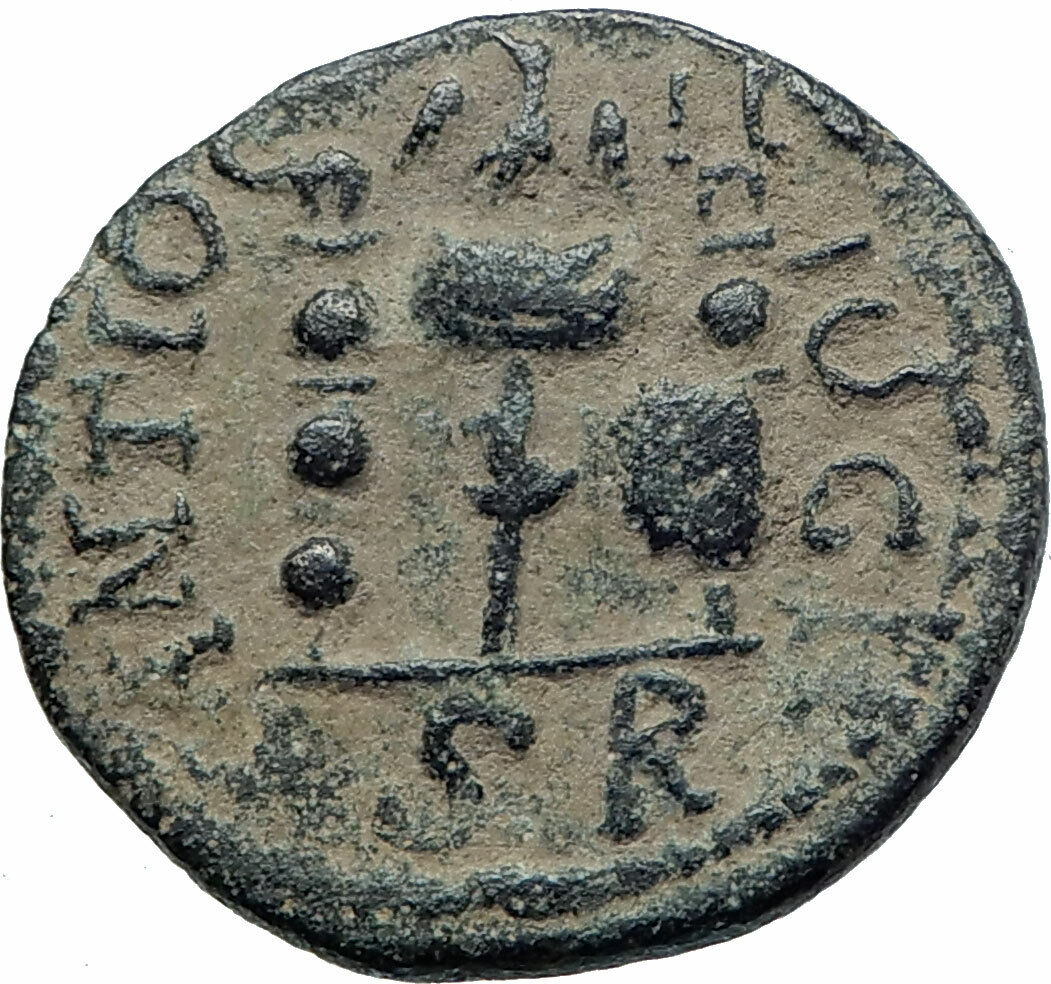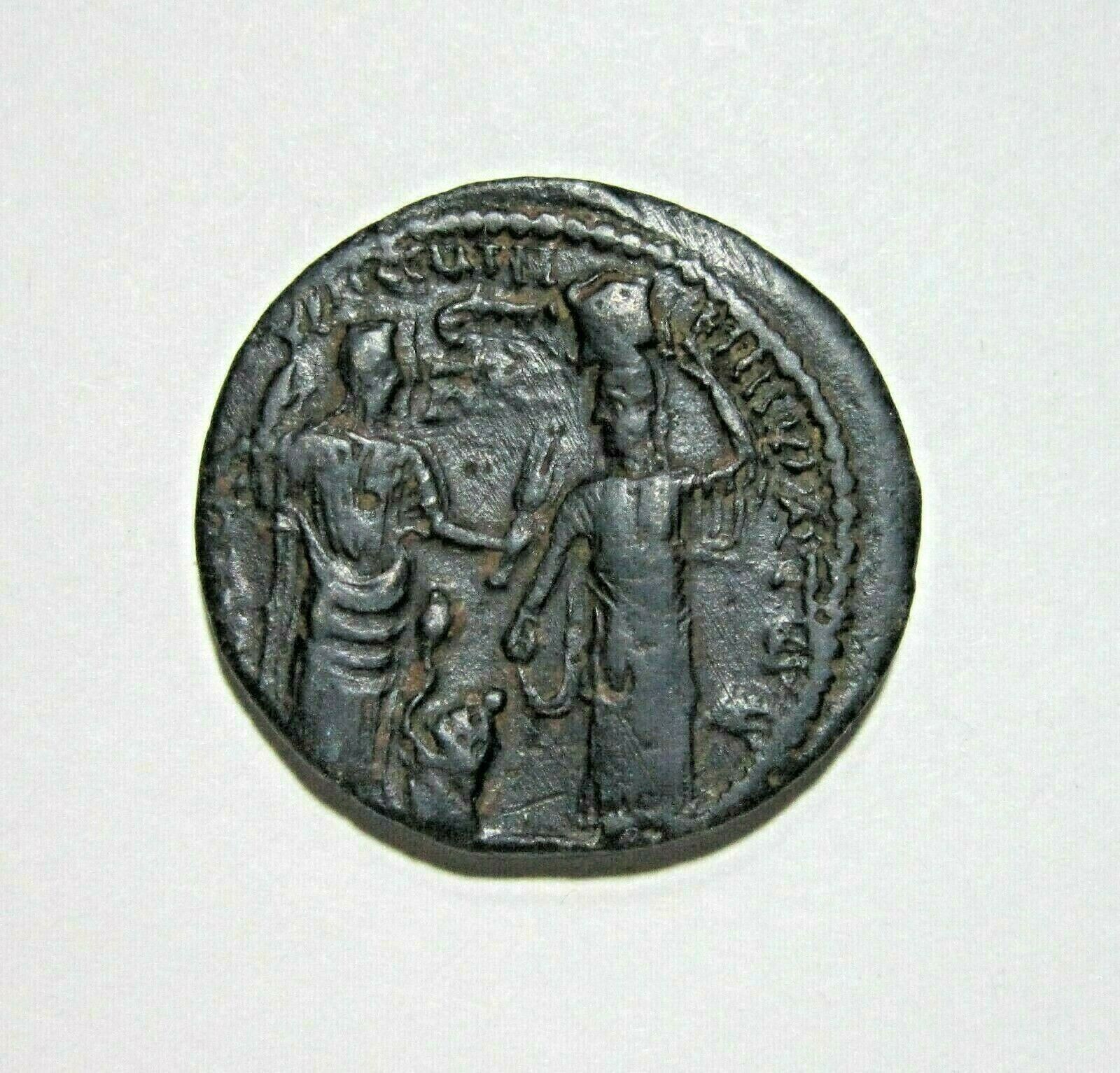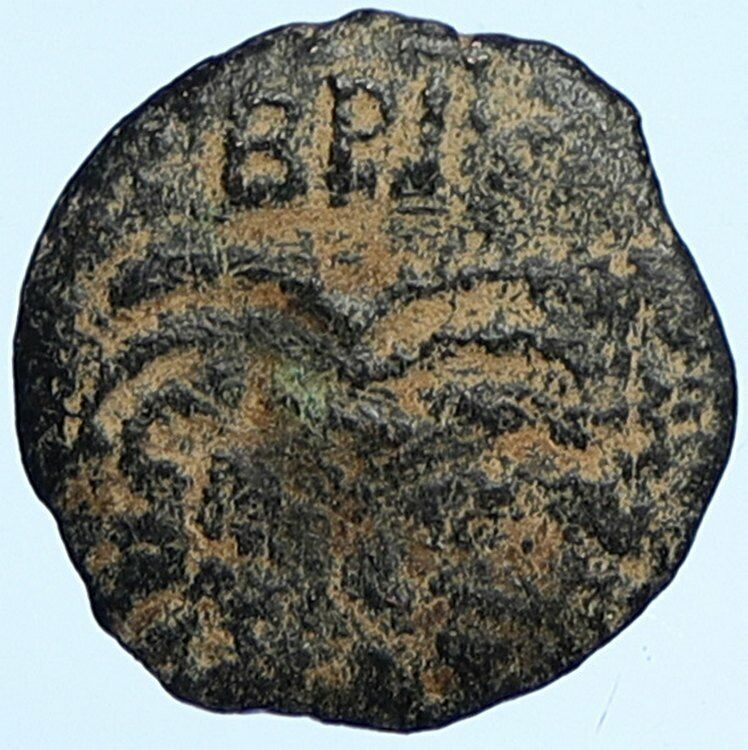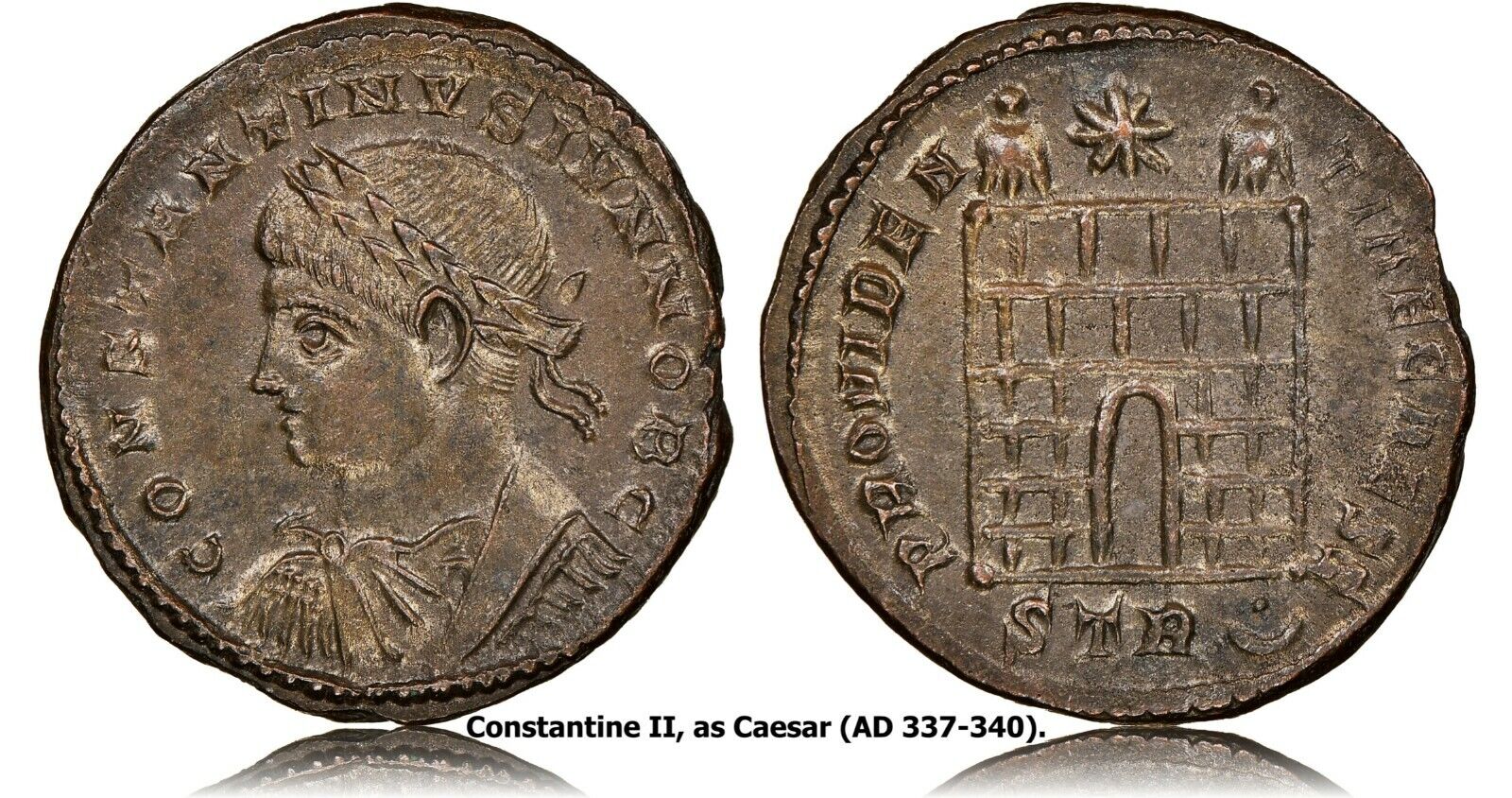-40%
VALERIAN I Authentic Ancient Antioch Pisidia Roman Coin LEGION STANDARDS i79247
$ 52.16
- Description
- Size Guide
Description
Item:i79247
Authentic Ancient Coin of:
Valerian I
-
Roman Emperor
: 253-260 A.D.
Bronze 21mm (4.80 grams) of
Antioch
in
Pisidia
Reference: Krzyzanowska pl. XLVIII, VII and 31
IMP CAE RASLLOVNAHHIO, radiate, draped and cuirassed bust right.
ANTIOCHIO C, vexilium surmounted by eagle, between two legionary standards; SR in exergue.
The legends on the coins of Pisidian Antioch are usually blundered from the time of the reign of Volusian onwards.
You are bidding on the exact item pictured, provided with a Certificate of Authenticity and Lifetime Guarantee of Authenticity.
Antioch in Pisidia
- alternatively
Antiochia in Pisidia
or
Pisidian Antioch
(Greek: Ἀντιόχεια τῆς Πισιδίας) and in Roman Empire, Latin:
Antiochia Caesareia
or
Antiochia Caesaria
- is a city in the Turkish Lakes Region, which is at the crossroads of the Mediterranean, Aegean and Central Anatolian regions, and formerly on the border of Pisidia and Phrygia, hence also known as
Antiochia in Phrygia
. The site lies approximately 1 km northeast of Yalvaç, the modern town of Isparta Province. The city is on a hill with its highest point of 1236 m in the north.
Valerian I
-
Augustus
: A.D. 253-260 with Gallienus
Husband of
Mariniana
| Father of
Gallienus
| Grandfather of
Valerian II
and
Saloninus
Publius Licinius Valerianus
(c. 200 - after 260), commonly known in English as
Valerian
or
Valerian I
, was the Roman Emperor from 253 to 260.
Unlike the majority of the pretenders during the Crisis of the Third Centuryy, Valerian was of a noble and traditional senatorial family. Details of his early life are elusive, but for his marriage to Egnatia Mariniana, who gave him two sons: later emperor Publius Licinius Egnatius Gallienus and Valerianus Minor.
In 238 he was
princeps senatus
, and Gordian I negotiated through him for Senatorial acknowledgement for his claim as emperor. In 251, when Decius revived the censorship with legislative and executive powers so extensive that it practically embraced the civil authority of the emperor, Valerian was chosen censor by the Senate, though he declined to accept the post. Under Decius he was nominated governor of the Rhine provinces of Noricum and Raetia and retained the confidence of his successor, Trebonianus Gallus, who asked him for reinforcements to quell the rebellion of Aemilianus.
Rule and fall
Valerian's first act as emperor was to make his son Gallienus his colleague. In the beginning of his reign the affairs in Europe went from bad to worse and the whole West fell into disorder. In the East, Antioch had fallen into the hands of a Sassanid vassal, Armenia was occupied by Shapur I (Sapor). Valerian and Gallienus split the problems of the empire between the two, with the son taking the West and the father heading East to face the Persian threat.
By 257, Valerian had already recovered Antioch and returned the province of Syria to Roman control but in the following year, the Goths ravaged Asia Minor. Later in 259, he moved to Edessa, but an outbreak of plague killed a critical number of legionaries, weakening the Roman position in Edessa which was then besieged by the Persians. At the beginning of 260, Valerian was defeated in the Battle of Edessa and he arranged a meeting with Shapur to negotiate a peace settlement. The ceasefire was betrayed by Shapur who seized him and held him prisoner for the remainder of his life. Valerian's capture was a humiliating defeat for the Romans.
Gibbon, in
The History of the Decline and Fall of the Roman Empire
describes Valerian's fate:
The voice of history, which is often little more than the organ of hatred or flattery, reproaches Sapor with a proud abuse of the rights of conquest. We are told that Valerian, in chains, but invested with the Imperial purple, was exposed to the multitude, a constant spectacle of fallen greatness; and that whenever the Persian monarch mounted on horseback, he placed his foot on the neck of a Roman emperor. Notwithstanding all the remonstrances of his allies, who repeatedly advised him to remember the vicissitudes of fortune, to dread the returning power of Rome, and to make his illustrious captive the pledge of peace, not the object of insult, Sapor still remained inflexible. When Valerian sunk under the weight of shame and grief, his skin, stuffed with straw, and formed into the likeness of a human figure, was preserved for ages in the most celebrated temple of Persia; a more real monument of triumph, than the fancied trophies of brass and marble so often erected by Roman vanity. The tale is moral and pathetic, but the truth of it may very fairly be called in question. The letters still extant from the princes of the East to Sapor are manifest forgeries; nor is it natural to suppose that a jealous monarch should, even in the person of a rival, thus publicly degrade the majesty of kings. Whatever treatment the unfortunate Valerian might experience in Persia, it is at least certain that the only emperor of Rome who had ever fallen into the hands of the enemy, languished away his life in hopeless captivity.
Valerian's massacre of 258
According to the Catholic Encyclopedia article on Valerian:
Pope Sixtus was seized on 6 August, 258, in one of the Catacombs and was put to death; Cyprian of Carthage suffered martyrdom on 14 September. Another celebrated martyr was the Roman deacon St. Lawrence. In Spain Bishop Fructuosus of Tarragona and his two deacons were put to death on 21 January, 259. There were also executions in the eastern provinces (Eusebius, VII, xii). Taken altogether, however, the repressions were limited to scattered spots and had no great success..
Death in captivity
An early Christian source, Lactantius, maintained that for some time prior to his death Valerian was subjected to the greatest insults by his captors, such as being used as a human footstool by Shapur when mounting his horse. According to this version of events, after a long period of such treatment Valerian offered Shapur a huge ransom for his release. In reply, according to one version, Shapur was said to have forced Valerian to swallow molten gold (the other version of his death is almost the same but it says that Valerian was killed by being flayed alive) and then had the unfortunate Valerian skinned and his skin stuffed with straw and preserved as a trophy in the main Persian temple. It was further alleged by Lactantius that it was only after a later Persian defeat against Rome that his skin was given a cremation and burial. The role of a Chinese prince held hostage by Shapur I, in the events following the death of Valerian has been frequently debated by historians, without reaching any definitive conclusion.
The Humiliation of Emperor Valerian by Shapur I, pen and ink, Hans Holbein the Younger, ca. 1521
Some modern scholars believe that, contrary to Lactantius' account, Shapur I sent Valerian and some of his army to the city of Bishapur where they lived in relatively good condition. Shapur used the remaining soldiers in engineering and development plans.
Band-e Kaisar
(Caesar's dam) is one of the remnants of Roman engineering located near the ancient city of Susa. In all the stone carvings on Naghshe-Rostam, in Iran, Valerian is respected by holding hands with Shapur I, in sign of submission.
It is generally supposed that some of Lactantius' account is motivated by his desire to establish that persecutors of the Christians died fitting deaths; the story was repeated then and later by authors in the Roman Near East "fiercely hostile" to Persia.
Other modern scholars tend to give at least some credence to Lactantius' account.
Valerian and Gallienus' joint rule was threatened several times by usurpers. Despite several usurpation attempts, Gallienus secured the throne until his own assassination in 268.
Owing to imperfect and often contradictory sources, the chronology and details of this reign are very uncertain.
Frequently Asked Questions
Mr. Ilya Zlobin
, world-renowned expert numismatist, enthusiast, author and dealer in authentic ancient Greek, ancient Roman, ancient Byzantine, world coins & more.
Who am I dealing with?
You are dealing with Ilya Zlobin, ancient coin expert, enthusiast, author and dealer with an online store having a selection of over 15,000 items with great positive feedback from verified buyers and over 10 years experience dealing with over 57,000 ancient and world coins and artifacts. Ilya Zlobin is an independent individual who has a passion for coin collecting, research and understanding the importance of the historical context and significance all coins and objects represent. Most others are only concerned with selling you, Ilya Zlobin is most interested in educating you on the subject, and providing the largest selection, most professional presentation and service for the best long-term value for collectors worldwide creating returning patrons sharing in the passion of ancient and world coin collecting for a lifetime.
How long until my order is shipped?
Orders are shipped by the next business day (after receipt of payment) most of the time.
How will I know when the order was shipped?
After your order has shipped, you will be left positive feedback, and that date could be used as a basis of estimating an arrival date. Any tracking number would be found under your 'Purchase history' tab.
USPS First Class mail takes about 3-5 business days to arrive in the U.S. International shipping times cannot be estimated as they vary from country to country.
Standard international mail to many countries
does not
include a tracking number, and can also be slow sometimes.
For a tracking number and signature confirmation, you may want to do Express Mail International Shipping, which costs more, however, is the fastest and most secure. Additionally you may be able to receive your order in as little as 3-5 business days using this method. For Express Mail International, it may be possible to place up to 10-15 items in one package (for the one shipping cost) as it is flat rate envelope, which may be the most cost-effective, secure and fastest way to receive items internationally. Send me a message about this and I can update your invoice should you want this method.
Getting your order to you, quickly and securely is a top priority and is taken seriously here.
Great care is taken in packaging and mailing every item securely and quickly.
Please be aware, I cannot take responsibility for any postal service delivery delays, especially for international packages as it may happen in rare instances.
What is a certificate of authenticity and what guarantees do you give that the item is authentic?
Each of the items sold here, is provided with a Certificate of Authenticity, and a Lifetime Guarantee of Authenticity, issued by a world-renowned numismatic and antique expert that has identified over 57,000 ancient coins and has provided them with the same guarantee. You will be very happy with what you get with the COA; a professional presentation of the coin, with all of the relevant information and a picture of the coin you saw in the listing. Additionally, the coin is inside it's own protective coin flip (holder), with a 2x2 inch description of the coin matching the individual number on the COA.
On the free-market such a presentation alone, can be considered a - value all in itself, and it comes standard with your purchases from me,
FREE.
With every purchase, you are leveraging my many years of experience to get a more complete context and understanding of the piece of history you are getting. Whether your goal is to collect or give the item as a gift, coins presented like this could be more prized and valued higher than items that were not given such care and attention to.
Buy a coin today and own a piece of history, guaranteed.
Is there a money back guarantee?
I offer a 30 day unconditional money back guarantee. I stand behind my coins and would be willing to exchange your order for either store credit towards other coins, or refund, minus shipping expenses, within 30 days from the receipt of your order. My goal is to have the returning customers for a lifetime, and I am so sure in my coins, their authenticity, numismatic value and beauty, I can offer such a guarantee.
When should I leave feedback?
Once you receive your order, please leave a positive feedback. Please don't leave any negative feedbacks, as it happens sometimes that people rush to leave feedback before letting sufficient time for their order to arrive. Also, if you sent an email, make sure to check for my reply in your messages before claiming that you didn't receive a response. The matter of fact is that any issues can be resolved, as reputation is most important to me. My goal is to provide superior products and quality of service.
How and where do I learn more about collecting ancient coins?
Visit the "
Guide on How to Use My Store
" for on an overview about using my store, with additional information and links to all other parts of my store which may include educational information on topics you are looking for.











